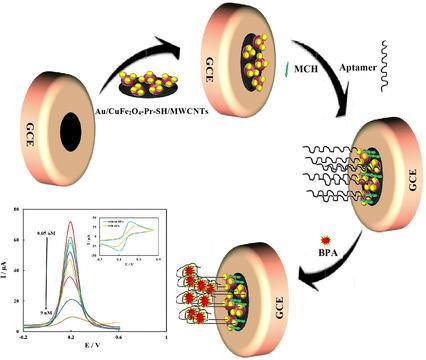当前位置:
X-MOL 学术
›
Electroanalysis
›
论文详情
Our official English website, www.x-mol.net, welcomes your feedback! (Note: you will need to create a separate account there.)
Label‐free Electrochemical Bisphenol A Aptasensor Based on Designing and Fabrication of a Magnetic Gold Nanocomposite
Electroanalysis ( IF 3 ) Pub Date : 2018-06-14 , DOI: 10.1002/elan.201800158 Mehdi Baghayeri 1 , Reza Ansari 2 , Marzieh Nodehi 2 , Iman Razavipanah 3 , Hojat Veisi 4
Electroanalysis ( IF 3 ) Pub Date : 2018-06-14 , DOI: 10.1002/elan.201800158 Mehdi Baghayeri 1 , Reza Ansari 2 , Marzieh Nodehi 2 , Iman Razavipanah 3 , Hojat Veisi 4
Affiliation

|
The present study focuses on designing and fabricating an electrochemical aptasensor for the label free detection of bisphenol A (BPA) using gold nanoparticles (Au NPs) immobilized on functional cupper magnetic nanoparticles (CuFe2O4‐SH) and multiwall carbon nanotubes (MWCNTs) modified with aptamer and 6‐mercapto‐1‐hexanol (MCH). A number of analysis techniques were used to characterize the nanocomposite, including Fourier transform infrared spectroscopy, field emission scanning electron microscopy, transmission electron microscopy, vibrating sample magnetometer, elemental mapping analysis and energy dispersive x‐ray diffraction. The results of the analyses revealed that the fabricated aptasensor had an acceptable linearity index (0.05‐9 nM) with an ultralow detection limit (25.2 pM) when used to determine BPA. Electrochemical experiments were conducted using a [Fe(CN)6]3−/[Fe(CN)6]4− redox system. The results of the electrochemical tests indicated that the existence of Au NPs along with magnetic nanoparticles and MWCNTs in nanocomposite led to a synergistic augmentation on the surface of the modified electrode, thus facilitating the efficient sensing of BPA. This method is highly selective, sensitive and environmentally friendly. Moreover, proposed aptasensor has valuable potential applications in medical diagnostics and food industries where a fast and reliable detection of BPA is of paramount importance for the health of the public.
中文翻译:

基于磁性金纳米复合材料的设计和制造的无标签电化学双酚A自适应传感器
本研究致力于设计和制造一种电化学适体传感器,用于使用固定在功能性铜磁性纳米颗粒(CuFe 2 O 4)上的金纳米颗粒(Au NPs)进行无标记双酚A(BPA)检测。-SH)和使用适体和6-巯基-1-己醇(MCH)改性的多壁碳纳米管(MWCNT)。使用了许多分析技术来表征纳米复合材料,包括傅立叶变换红外光谱,场发射扫描电子显微镜,透射电子显微镜,振动样品磁力计,元素图分析和能量色散X射线衍射。分析结果表明,制成的适体传感器在用于测定BPA时具有可接受的线性指数(0.05-9 nM),且检测限超低(25.2 pM)。电化学实验是使用[Fe(CN)6 ] 3− / [Fe(CN)6 ] 4−进行的氧化还原系统。电化学测试的结果表明,纳米复合物中金纳米颗粒以及磁性纳米颗粒和多壁碳纳米管的存在导致修饰电极表面的协同增效,从而促进了BPA的高效感测。该方法具有高度选择性,灵敏性和环境友好性。此外,提出的适体传感器在医学诊断和食品工业中具有有价值的潜在应用,在这些行业中,快速,可靠地检测BPA对于公众健康至关重要。
更新日期:2018-06-14
中文翻译:

基于磁性金纳米复合材料的设计和制造的无标签电化学双酚A自适应传感器
本研究致力于设计和制造一种电化学适体传感器,用于使用固定在功能性铜磁性纳米颗粒(CuFe 2 O 4)上的金纳米颗粒(Au NPs)进行无标记双酚A(BPA)检测。-SH)和使用适体和6-巯基-1-己醇(MCH)改性的多壁碳纳米管(MWCNT)。使用了许多分析技术来表征纳米复合材料,包括傅立叶变换红外光谱,场发射扫描电子显微镜,透射电子显微镜,振动样品磁力计,元素图分析和能量色散X射线衍射。分析结果表明,制成的适体传感器在用于测定BPA时具有可接受的线性指数(0.05-9 nM),且检测限超低(25.2 pM)。电化学实验是使用[Fe(CN)6 ] 3− / [Fe(CN)6 ] 4−进行的氧化还原系统。电化学测试的结果表明,纳米复合物中金纳米颗粒以及磁性纳米颗粒和多壁碳纳米管的存在导致修饰电极表面的协同增效,从而促进了BPA的高效感测。该方法具有高度选择性,灵敏性和环境友好性。此外,提出的适体传感器在医学诊断和食品工业中具有有价值的潜在应用,在这些行业中,快速,可靠地检测BPA对于公众健康至关重要。



























 京公网安备 11010802027423号
京公网安备 11010802027423号